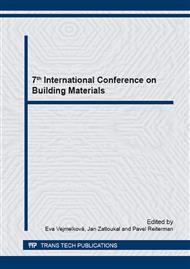[1]
J. Dweck, M.B.M. Melchert, M.M. Viana, F.K. Cartledge, P.M. Büchler, Importance of quantitative thermogravimetry on initial cement mass basis to evaluate the hydration of cement pastes and mortars, J. Therm. Anal. Calorim. 113 (2013) 1481-1490.
DOI: 10.1007/s10973-013-3112-5
Google Scholar
[2]
A.N. Junior, R.D.T. Filho, E.M.R. Fairbairn, J. Dweck, Early stages hydration of high initial strength Portland cement. Part I. thermogravimetric analysis on calcined mass basis, J. Therm. Anal. Calorim. 108 (2012) 725-731.
DOI: 10.1007/s10973-012-2256-z
Google Scholar
[3]
R. Vedalakshmi, A.S. Raj, S. Srinivasan, K.G. Babu, Quantification of hydrated cement products of blended cements in low and medium strength concrete using TG and DTA technique, Thermochim. Acta. 407 (2003) 49-60.
DOI: 10.1016/s0040-6031(03)00286-7
Google Scholar
[4]
A. Mellado, M.V. Borrachero, L. Soriano, J. Paya, J. Monzó, Immobilization of Zn (II) in Portland cement pastes, J. Therm. Anal. Calorim. 112 (2013) 1377-1389.
DOI: 10.1007/s10973-012-2705-8
Google Scholar
[5]
J. Payá, J. Monzó, M.V. Borrachero, S. Velázquez, Evaluation of the pozzolanic activity of fluid catalytic cracking catalyst residue (FC3R). Thermogravimetric analysis studies on FC3R-Portland cement pastes, Cement Concrete Res. 33 (2003) 603-609.
DOI: 10.1016/s0008-8846(02)01026-8
Google Scholar
[6]
X.C. Qiao, C.S. Poon, C.R. Cheeseman, Investigation into the stabilization/solidification performance of Portland cement through cement clinker phases, J. Hazard. Mater. 139 (2007) 238-243.
DOI: 10.1016/j.jhazmat.2006.06.009
Google Scholar
[7]
K. De Weerdt, M.B. Haha, G. Le Saout, K.O. Kjellsen, H. Justnes, B. Lothenbach, Hydration mechanisms of ternary Portland cements containing limestone powder and fly ash, Cement Concrete Res. 41 (2011) 279-291.
DOI: 10.1016/j.cemconres.2010.11.014
Google Scholar
[8]
S. Liu, Y. Kong, L. Wang, A comparison of hydration properties of cement–low quality fly ash binder and cement–limestone powder binder, J. Therm. Anal. Calorim. 116 (2014) 937-943.
DOI: 10.1007/s10973-013-3576-3
Google Scholar
[9]
P. Thongsanitgarn, W. Wongkeo, A. Chaipanich, Hydration and Compressive Strength of Blended Cement Containing Fly Ash and Limestone as Cement Replacement, J. Mater. Civ. Eng. 26 (2014) 04014088.
DOI: 10.1061/(asce)mt.1943-5533.0001002
Google Scholar
[10]
T.D. Dyer, R.K. Dhir, Hydration reactions of cement combinations containing vitrified incinerator fly ash, Cement Concrete Res. 34 (2004) 849-856.
DOI: 10.1016/j.cemconres.2003.09.025
Google Scholar
[11]
M. Frias, J. Cabrera, Pore size distribution and degree of hydration of metakaolin–cement pastes. Cement Concrete Res. 30 (2000) 561-569.
DOI: 10.1016/s0008-8846(00)00203-9
Google Scholar
[12]
M. Antoni, J. Rossen, F. Martirena, K. Scrivener, Cement substitution by a combination of metakaolin and limestone, Cement Concrete Res. 42 (2012) 1579-1589.
DOI: 10.1016/j.cemconres.2012.09.006
Google Scholar
[13]
J. Wei, C. Meyer, Sisal fiber-reinforced cement composite with Portland cement substitution by a combination of metakaolin and nanoclay, J. Mater. Sci. 49 (2014) 7604-7619.
DOI: 10.1007/s10853-014-8469-8
Google Scholar
[14]
E. Gruyaert, N. Robeyst, N. De Belie, Study of the hydration of Portland cement blended with blast-furnace slag by calorimetry and thermogravimetry, J. Therm. Anal. Calorim. 102 (2010) 941-951.
DOI: 10.1007/s10973-010-0841-6
Google Scholar
[15]
J. Dweck, P.M. Buchler, F.K. Cartledge, The effect of different bentonites on cement hydration during solidification/stabilization of tannery wastes, J. Therm. Anal. Calorim. 64 (2001) 1011-1016.
Google Scholar
[16]
S. Horpibulsuk, R. Rachan, A. Suddeepong, Assessment of strength development in blended cement admixed Bangkok clay, Constr. Build. Mater. 25 (2011) 1521-1531.
DOI: 10.1016/j.conbuildmat.2010.08.006
Google Scholar
[17]
S. Horpibulsuk, W. Phojan, A. Suddeepong, A. Chinkulkijniwat, M.D. Liu, Strength development in blended cement admixed saline clay, Appl. Clay Sci. 55 (2012) 44-52.
DOI: 10.1016/j.clay.2011.10.003
Google Scholar
[18]
J.I. Escalante, G. Mendoza, H. Mancha, J. Lopez, G. Vargas, Pozzolanic properties of a geothermal silica waste material, Cement Concrete Res. 29 (1999) 623-625.
DOI: 10.1016/s0008-8846(98)00238-5
Google Scholar
[19]
K.L. Lin, B.Y. Chen, C.S. Chiou, A. Cheng, Waste brick's potential for use as a pozzolan in blended Portland cement, Waste Manage. Res. 28 (2010) 647-652.
DOI: 10.1177/0734242x09355853
Google Scholar
[20]
F. Pelisser, L.R. Steiner, A.M. Bernardin, Recycling of Porcelain Tile Polishing Residue in Portland Cement: Hydration Efficiency, Environ. Sci. Technol. 46 (2012) 2368-2374.
DOI: 10.1021/es203118w
Google Scholar
[21]
M.A.S. Anjos, A.E. Martinelli, D.M.A. Melo, T. Renovato, P.D.P. Souza, J.C. Freitas, Hydration of oil well cement containing sugarcane biomass waste as a function of curing temperature and pressure, J. Petrol. Sci. Eng. 109 (2013) 291-297.
DOI: 10.1016/j.petrol.2013.08.016
Google Scholar
[22]
A. Govin, A. Peschard, R. Guyonnet, Modification of cement hydration at early ages by natural and heated wood. Cement Concrete Comp. 28 (2006) 12-20.
DOI: 10.1016/j.cemconcomp.2005.09.002
Google Scholar
[23]
A. Peschard, A. Govin, P. Grosseau, B. Guilhot, R. Guyonnet, Effect of polysaccharides on the hydration of cement paste at early ages, Cement Concrete Res. 34 (2004) 2153-2158.
DOI: 10.1016/j.cemconres.2004.04.001
Google Scholar
[24]
A.V. Soin, L.J.J. Catalan, S.D. Kinrade, A combined QXRD/TG method to quantify the phase composition of hydrated Portland cements, Cement Concrete Res. 48 (2013) 17-24.
DOI: 10.1016/j.cemconres.2013.02.007
Google Scholar
[25]
J. Dweck, P.F. Ferreira da Silva, P.M. Büchler, F.K. Cartledge, Study by thermogravimetry of the evolution of ettringite phase during type II Portland cement hydration, J. Therm. Anal. Calorim. 69 (2002) 179-186.
Google Scholar
[26]
W. Sha, G.B. Pereira, Differential scanning calorimetry study of ordinary Portland cement paste containing metakaolin and theoretical approach of metakaolin activity, Cement Concrete Comp 23 (2001) 455–461.
DOI: 10.1016/s0958-9465(00)00090-1
Google Scholar
[27]
M.J. Heap, Y. Lavallée, A. Laumann, K.U. Hess, P.G. Meredith, D.B. Dingwell, S. Huismann, F. Weise, The influence of thermal-stressing (up to 1000 °C) on the physical, mechanical, and chemical properties of siliceous-aggregate, high-strength concrete, Constr. Build. Mater. 42 (2013).
DOI: 10.1016/j.conbuildmat.2013.01.020
Google Scholar
[27]
W. Sha, E.A. O'Neill, Z. Guo, Differential scanning calorimetry study of ordinary Portland cement, Cement Concrete Res. 29 (1999) 1487–1489.
DOI: 10.1016/s0008-8846(99)00128-3
Google Scholar
[29]
L.P. Esteves, On the hydration of water-entrained cement–silica systems: Combined SEM, XRD and thermal analysis in cement pastes, Thermochim. Acta 518 (2011) 27-35.
DOI: 10.1016/j.tca.2011.02.003
Google Scholar
[30]
I. Janotka, Hydration of the cement paste with Na2CO3 addition, Silicates 45 (2001) 16-23.
Google Scholar
[31]
J. Dweck, P.M. Buchler, A.C.V. Coelho, F.K. Cartledge, Hydration of a Portland cement blended with calcium carbonate, Thermochim. Acta 346(2000) 105-113.
DOI: 10.1016/s0040-6031(99)00369-x
Google Scholar


